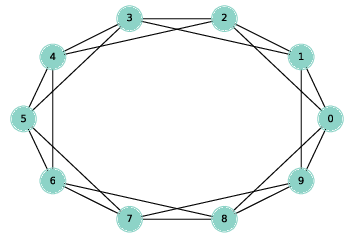5.4. Ring lattice¶

Figure 5.1: A ring lattice with \(n=10\) and \(k=4\).¶
A regular graph is a graph where each node has the same number of neighbors; the number of neighbors is also called the degree of the node.
A ring lattice is a kind of regular graph, which Watts and Strogatz use as the basis of their model. In a ring lattice with \(n\) nodes, the nodes can be arranged in a circle with each node connected to the \(k\) nearest neighbors.
For example, a ring lattice with \(n=3\) and \(k=2\) would contain the following edges: \((0, 1)\), \((1, 2)\), and \((2, 0)\). Notice that the edges “wrap around” from the highest-numbered node back to \(0\).
More generally, we can enumerate the edges like this:
def adjacent_edges(nodes, halfk):
n = len(nodes)
for i, u in enumerate(nodes):
for j in range(i+1, i+halfk+1):
v = nodes[j % n]
yield u, v
adjacent_edges takes a list of nodes and a parameter, halfk, which is half of \(k\). It is a generator function that yields one edge at a time. It uses the modulus operator, \(\%\), to wrap around from the highest-numbered node to the lowest.
We can test it like this:
>>> nodes = range(3)
>>> for edge in adjacent_edges(nodes, 1):
... print(edge)
(0, 1)
(1, 2)
(2, 0)
Now we can use adjacent_edges to make a ring lattice:
def make_ring_lattice(n, k):
G = nx.Graph()
nodes = range(n)
G.add_nodes_from(nodes)
G.add_edges_from(adjacent_edges(nodes, k//2))
return G
Notice that make_ring_lattice uses floor division to compute halfk, so it is only correct if k is even. If k is odd, floor division rounds down, so the result is a ring lattice with degree k-1. As one of the exercises at the end of the chapter, you will generate regular graphs with odd values of k.
We can test make_ring_lattice like this:
lattice = make_ring_lattice(10, 4)
Figure 5.1 shows the result.